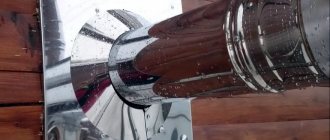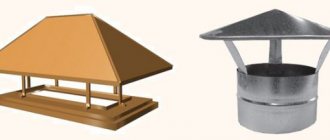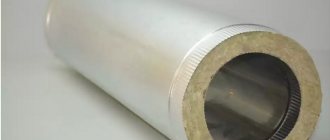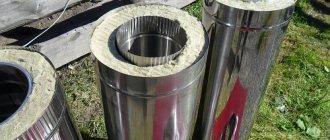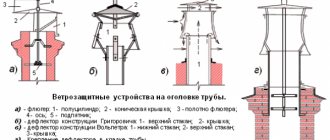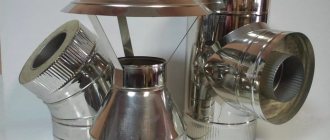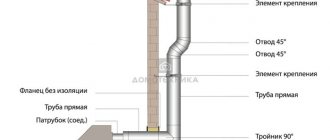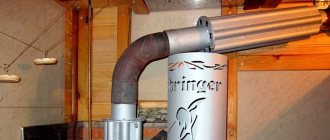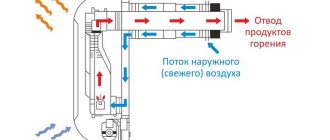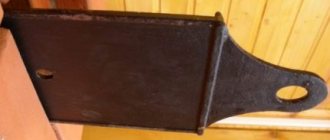There is not a single stove without a chimney. The removal of carbon monoxide and smoke from the firebox is a necessary condition for the proper operation of the stove. What should the pipe be made of and how to arrange it so that it lasts for a long time and does not create additional problems? An experienced stove maker will answer without hesitation - from the same material as the stove itself. This is due to the fact that different materials have different coefficients of thermal expansion. And if brick and metal are heated at the same time during the fire, then a gap will form at the point of their connection over time. Smoke begins to leak through the gap, this disrupts the smooth operation of the stove, and also poses a serious threat to the life and health of household members. Therefore, if you want to build a chimney for a brick stove, you must also do it from brick.
- 2 Chimney pipe design and operating principle
- 3 Calculation of the main parameters of the pipe
3.1 Video: how to calculate the height of the chimney
- 4.1 Materials and tools required for chimney construction
4.3.1 Video: do-it-yourself chimney for a fireplace
- 5.1 Video: chimney insulation
What is a brick chimney and where is it used?
Chimneys are used to remove gaseous combustion products in stoves, fireplaces and heating boilers. Under the influence of draft, smoke, carbon monoxide and soot are carried from the firebox into the chimney and discharged outside. As they move, they cool down, giving off heat to the walls of the chimney.
To remove combustion products from a brick stove, you need to build a chimney from the same material, i.e. brick
Unlike metal pipes, a brick chimney has:
- Higher heat capacity coefficient. Because of this, the efficiency of such chimneys is higher. By accumulating heat inside itself, the brick gradually releases it into the living space, thereby prolonging the heating time of the air.
- High thermal resistance. The temperature of gases as a result of fuel combustion reaches 800 ° C. Metal chimneys, when heated to such a temperature, “burn out” over time, become deformed, and water condensation forms on the walls. Mixing with soot, water turns into an aggressive chemical reagent.
- Variety of architectural forms. The brick pipe fits organically into the style of the building and gives it additional design. The massiveness of the chimney makes the pipe resistant to mechanical damage and little susceptible to the effects of natural atmospheric phenomena. Metal pipes, on the contrary, must be carefully secured, in some cases even braces must be used.
A brick pipe can serve as an architectural decoration for a home and does not require additional fastening, regardless of its size
But a brick chimney also has a rather significant disadvantage. In country houses and country cottages it is not possible to fold cylindrical pipes, which are ideal for the passage of hot gases. The internal cross-section of a square or rectangular shape creates obstacles to the flow of smoke. As a result, a layer of soot quickly forms on the inner walls, which reduces traction.
Accordingly, they have to be cleaned more often than metal ones.
Varieties
There are several types of chimneys. They are classified depending on their location relative to the furnace itself:
- Mounted pipe. Due to its simplicity of design and ease of installation, it is perhaps the most common. The mounted pipe is mounted directly above the heating structure, being its continuation. Often installed on cast iron or small sauna stoves.
- Root chimney. Such a pipe is mounted next to the furnace on its own foundation, closely adjacent to one of its sides. The basic structure is convenient to use for multi-story buildings, where several heating elements on different floors can be connected to one chimney. For such cases, an accurate calculation of the parameters is required, otherwise the chimney will not provide the necessary draft.
- Wall pipe. Built into the external or internal main wall of the house. The external version should be carefully insulated, since due to the difference in temperatures inside and outside the structure, condensation can accumulate in the chimney, leading to the accumulation of soot and a decrease in draft.
We recommend that you familiarize yourself with: Pipe routing diagrams and options for installing a heating system in a private house with your own hands
Based on their location to the building, chimneys can be divided into internal and external:
- Internal chimneys provide good draft, but are more difficult to install because they require transitions through the ceilings and roof.
- External chimneys are more convenient in terms of installation (especially in an already built residential building) and maintenance. It is not always possible to give such chimneys an aesthetic shape. In addition, the external surfaces of the structure need to be insulated.
Chimney pipe design and operating principle
The classic chimney design is a vertical tower, inside of which there is a through hole that connects the furnace firebox with the open space outside the house. According to the laws of physics, air pressure decreases with distance from the earth's surface. As a result, a draft arises inside the pipe - the tendency of the air mass to move from bottom to top. If the air access from below is blocked, the draft disappears. Therefore, a smoke damper or view must be installed in the chimney, with the help of which it is possible to regulate the draft.
Using the damper, you can regulate the size of the smoke channel, and therefore the draft
Since the pipe is used in residential buildings, it should not pose a fire hazard, therefore the masonry is carried out taking into account maximum protection from possible fire. A certain terminology has become established among stove makers, which reflects the structure and functional purpose of individual pipe elements.
- Extension pipe. Placed directly on the stove, connected to the combustion chamber. Usually it does not reach the horizontal ceiling by 5–6 brick rows (35–40 cm). A valve is located in this part.
- Fluffing (or cutting). Thickening of the outer casing inside the ceiling. The goal is to prevent thermal contact of the floor material and cross beams with the pipe. In this place, the temperature of the bricks reaches its maximum values, so it is important to take all safety measures. The internal dimensions of the chimney remain unchanged.
- Riser. Part of the pipe from the fluff to the roof. The dimensions of the riser usually coincide with the dimensions of the extension pipe. The size of the internal section is maintained. If the attic space is equipped as a living space, the riser serves as a heater.
- Otter. Thickening the external dimensions of the chimney in order to block the hole in the roof from possible precipitation. The minimum overlap is 10 cm around the entire perimeter of the pipe. The height of the otter depends on the slope of the roof. Its upper part ends with waste areas made of cement mortar with increased moisture resistance.
- Pipe neck. Part of the chimney made by laying bricks on a waterproof mortar. It is located above the otter and has the same geometric parameters as the riser.
- Pipe head. Extension of brickwork at the end of a chimney. It has protective functions and prevents foreign objects from entering the pipe. Often reinforced with a metal frame, deflector or weather vane.
All brick chimneys are made according to the same scheme, consisting of several standard elements
In some cases, a combined pipe design is practiced. The brickwork ends in the attic and then a metal or asbestos pipe is mounted to it, leading to the roof. In this case, there is no need for an otter, neck and head, which significantly saves time and money. At the same time, we must not forget that the cross-sectional area of a metal pipe should not differ from the cross-section of a brick pipe in a smaller direction. The combination of a stainless steel pipe embedded in an asbestos pipe has proven itself well.
In the upper part of the chimney, where the temperature of the flue gases is not so high, you can make a transition from a brick pipe to a metal one
In both cases, the top hole must be closed with an umbrella (or deflector), which will prevent rain and snow from directly entering the pipe.
You can read in detail about the principles of choosing a suitable chimney in our article:.
Ceramic
Ceramic chimneys are produced only in factory conditions. This is a completely ready-made modular system.
The advantages are as follows:
- perfectly withstand high temperatures;
- acid-resistant;
- service life is very long.
Thanks to the smooth internal surface, turbulent turbulence does not form, and gas flows smoothly throughout the entire system.
The ceramic system has good weight, so it is installed on a separate foundation.
Calculation of main pipe parameters
All calculations for the chimney must be performed at the design stage of the stove. The project must be carried out by a qualified engineer or craftsman who is well versed in all the nuances of the furnace business. It is impossible to plan the dimensions of the pipe in isolation from the dimensions of the firebox and heat exchanger. Everything is interconnected and must correspond to one goal - the coordinated operation of the furnace equipment.
If, when building a fireplace, the “body” of the stove is missing, and the firebox is directly connected to the chimney, then the Russian stove additionally has heating ducts in the walls, and it is impossible not to make allowances for this. The presence of passages changes the draft and lengthens the path of the flue gases several times. Accordingly, the chimney must create greater vacuum so that the movement of gases is accelerated and soot does not settle inside the passage. A separate topic could be the calculation of the parameters of the chimney in a sauna stove. It is important here that the draft is not excessive, and that the burning fuel has time to transfer heat inside the steam room.
The stove maker’s task includes taking into account not only internal, but also external factors - the location of the pipe in relation to the roof, the characteristics of the local climate, and even the influence of the landscape.
The chimney draft can be affected by tall buildings and trees located nearby, as well as by incorrect choice of chimney height
For gas heating systems, due to their increased fire hazard, the calculation of the chimney parameters is carried out by specialists who develop the boiler. The dimensions are indicated in the technical data sheet and are mandatory.
In private construction, where the combustion is carried out mainly with solid fuel (wood, coal, peat or fuel briquettes), you can adhere to the following rules that will ensure the correct operation of any stove:
- the internal cross-sectional area of a rectangular chimney in closed-type furnaces should not exceed the cross-sectional area of the blower;
- the internal cross-sectional area of the pipe in open-type stoves and fireplaces is calculated in a ratio of 1:10 in relation to the firebox.
It is believed that if the chimney structure has a rectangular shape, the ratio of the short side to the long side should be equal to 1:2. In this case, the minimum permissible cross-sectional size of the channel is 14 x 14 cm.
The size of the brick chimney channel wall should not be less than 14 cm
An important factor is the height of the pipe. Correct calculation allows:
- optimize the operation of the chimney and achieve better efficiency indicators for heat transfer;
- ensure safe operation of the heating device, eliminate the leakage of harmful gases due to weak draft;
- ensure fire safety - if the draft is excessive, sparks and flames may fly out of the pipe.
In general, the height is determined in accordance with SNiP 2.04.05–91:
- the minimum distance from the grate to the top point of the chimney (excluding the protective umbrella) is 5 m;
- the optimal distance is 6 m.
Such parameters ensure stable draft, i.e. the design of the chimney allows you to create a pressure drop sufficient to operate the stove at any time of the year. But in each particular case it is also necessary to take into account:
- The height of the chimney head in relation to the roof ridge. It should be located:
- 0.5 m above the ridge if the chimney is within 1.5 m;
at the level of the ridge, if the chimney is removed at a distance of 1.5 to 3 m;
- not lower than a conventional line drawn from the highest point of the roof at an angle of 10° to the horizontal, in other cases.
- Roof structure, slab thickness, roof slope angle. The length of the riser and the height of the otter depend on this.
- Roof type - single-pitch, gable, flat. There are specific standards for flat roofs: in the absence of parapets, the length of the chimney above the roof plane should be 1.2 m.
- The presence of other devices on the outside of a flat roof, such as ventilation shafts, parapets or protective curbs. With parapets and curbs, the required height increases to 2.2 m. The chimney is located no closer than 5 m from the ventilation hatch.
- Third-party factors - trees located near the house, tall buildings, cliffs, steep river banks. The presence of such factors can create a so-called wind pressure zone, which affects the traction force and interferes with the normal operation of the chimney. The solution to this problem, as a rule, is to increase the height of the pipe.
If there are tall buildings or trees near the house, the chimney must be lengthened, taking into account their top instead of the height of the ridge
The optimal height of the pipe head depends on its location relative to the roof ridge
There is such an unpleasant phenomenon as backdraft. This term refers to the movement of smoke in the chimney in the opposite direction - from the chimney duct into the room. There may be several reasons for this, but the main one is the incorrect position of the chimney. As a rule - underestimated.
An error in choosing the height of the chimney often leads to backdraft
Excess draft can always be eliminated by adjusting the air flow in the ash pan and smoke valves. Insufficient traction is exacerbated in several ways:
- Pipe extension.
- Cleaning the inner surface of the chimney duct.
- Installing a deflector.
The deflector not only increases draft, but also protects the chimney channel from moisture, debris and birds and bats settling in it.
According to experts, by installing a deflector on a chimney you can increase draft by 15–20%
Video: how to calculate the height of the chimney
You will learn about which pipe is best to choose for a chimney, as well as the advantages and disadvantages of materials in our material:.
Features of the operation of brick chimneys
After the construction of the chimney is completed and the pipe has been successfully put into operation, it is advisable to familiarize yourself with the features of using a brick stove. In order for the heating unit to serve for a long time and without accidents, it is necessary to follow simple but important rules.
- The main enemy of brick is sudden temperature changes. It is better to heat more often, but for short periods of time. It is not recommended to make more than 2 fuel loads per firebox. This is especially true for coal, the combustion temperature of which exceeds 1000 degrees.
- Timely cleaning of the pipe from soot unlimitedly extends the service life of the chimney duct.
- If cracks occur on the stove body and chimney in particular, measures should be taken immediately to eliminate them. Neglected cracks tend to progress quickly and pose a threat not only to the integrity of the brickwork, but also to human health. Carbon monoxide, which is colorless and odorless, but poisonous to all living things, penetrates into the living space through small cracks.
- The slightest malfunction in the doors of the firebox or ash chamber (ash chamber) first significantly reduces the heat transfer of the stove, and then leads to an avalanche-like accumulation of soot on the chimney channels. If you find a door, view or valve that does not close tightly, you should immediately repair or replace it.
- At least once a year it is necessary to carry out preventative maintenance on the furnace. It is best to do this at the end of summer, before the start of the heating season. A daily preventative procedure includes opening the blower door for 15–20 minutes. This simple action will allow you to briefly create maximum draft, which will pull the soot deposited on the walls into the external environment.
- The use of damp firewood has an adverse effect on the cleanliness of smoke ducts, especially in winter. It is more rational to use fuel briquettes, the humidity of which is much lower. Firewood should be prepared ahead of time - drying wood naturally is a long process (from a year to two).
Chimney diagrams
Stove chimney diagram
The stove chimney diagram must be made taking into account all indicators. Do not forget to take into account the type of future fuel; at first glance, it does not play an important role, but during operation, you will become familiar with all the nuances. On the Internet you can find a lot of diagrams in which all the data is already written down, and you only need to fill in your house plan and dimensions. In addition, there are special services, so-called online calculators, where you enter the initial data on your stove and dimensions, and in response, the optimal chimney diameter, its length and other data are given, including wall thickness and the like.
